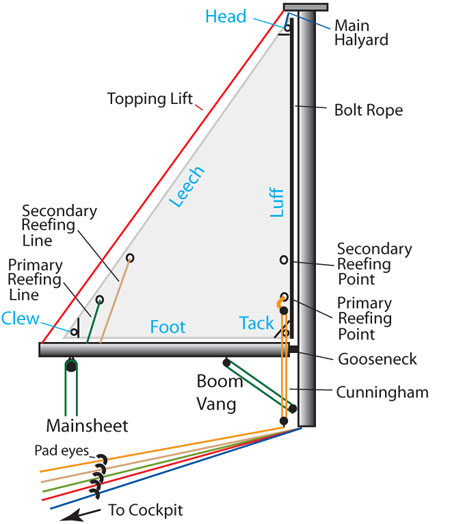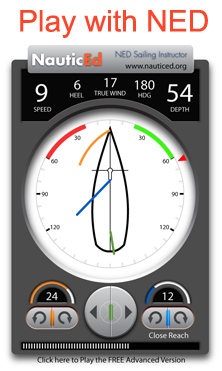In this NauticEd Sailing School learn to sail article we’re going to discuss the mainsail and some “thingys” that are attached to it and the function of those thingys.
The mainsail is literally “the Main Sail”. Every sailboat has a mainsail and it’s usually a triangular shape. It’s the one that is hoisted (pulled) up the mast and extends aft (towards the stern (rear) of the boat). The foot (bottom) of the mainsail is usually attached to the boom. The boom is a rigid horizontal spar that attaches to a position near the base of the mast and extends backwards towards the aft of the sailboat. The front bottom connection part of the mainsail is called the tack. It’s a very strong sewn in eye hole. Similarly the back bottom connection eye hole in the mainsail is called the clew. The foot of the sail usually slides into a track along the boom and is held taught along the boom by a line called the out haul attached to the clew by a D-ring. In some cases the foot of the mainsail is only attached to the tack and the clew. The attachment fitting which attaches the boom to the mast is called a gooseneck which allows the boom and thus the mainsail to swing from side to side. The leech (trailing edge) of the sail holds up the back of boom. On larger boats (20ft plus), when the mainsail is not hoisted there is a line from the top of the mast to the back of the boom called the boom topping lift. The boom topping lift holds up the back of the boom. However, as soon as the mainsail is hoisted, the boom topping lift line should become slack allowing the sail tension to take over this roll.
The leading edge of the mainsail is called the luff. It attaches to the mast in a few different ways. Sometimes there is a rope sewn into the luff. This rope is called a bolt rope and is one of the few ropes that exist on a boat. Another is called a bell rope although some sailors will claim there are no ropes on a boat. The bolt rope slides up into a track on the mast holding the mainsail securely in place. With other mainsail luffs, there are clips called hanks which are sewn into the leading edge approximately 30 cm apart. The hanks then slide into a track as the mainsail is hoisted.

The Main Sail
The line that hoists the mainsail up to the top of the mast is called a halyard. It is held to the top (head) of the mainsail by a D-ring, goes over a sheave (pulley) at the top of the mast and then down the mast to either a winch on the mast or through a few blocks and back to a winch near the cockpit.
Once we have the sail up. We’ll want to begin controlling the sail and adjusting to the wind. This is the most fun part of your learn to sail desire. To control how far the boom and thus mainsail swings out, we use the main sheet. Just remember that on a sailboat, sheets are lines which are ropes. The main sheet attaches to a block (pulley) near the back of the boom and down to the to center of the sailboat, usually in the cockpit. When we pull on the mainsheet the boom is pulled down and swings towards the center of the boat. When we let out the mainsheet the mainsail can swing out and is also allowed to rise up. Pulling in the mainsheet is called “tightening up the mainsheet” and letting out the mainsheet is called “easing the mainsheet” or “letting out the mainsheet”. Notice that we always refer to the line by name that we are adjusting so that there is no ambiguity.
There are a few other controlling lines of the mainsail which we’ll discuss in the next article. Even though you probably feel like you’re starting out with a test of some foreign language, understanding the names and functions of the mainsail is all part of the learn to sail routine.
For a free sailing course about sail trim, go to http://www.nauticed.org/freesailingcourse
To get some practice with trimming the sails go to our interactive sailing instructor at http://www.nauticed.org/sailing-instructor

Learn to Sail with NED
This learn to sail article was written by Grant Headifen, Educational Director of NauticEd. NauticEd is an online sailing school providing sailing courses and sailing certifications for beginner to advanced sailors.
